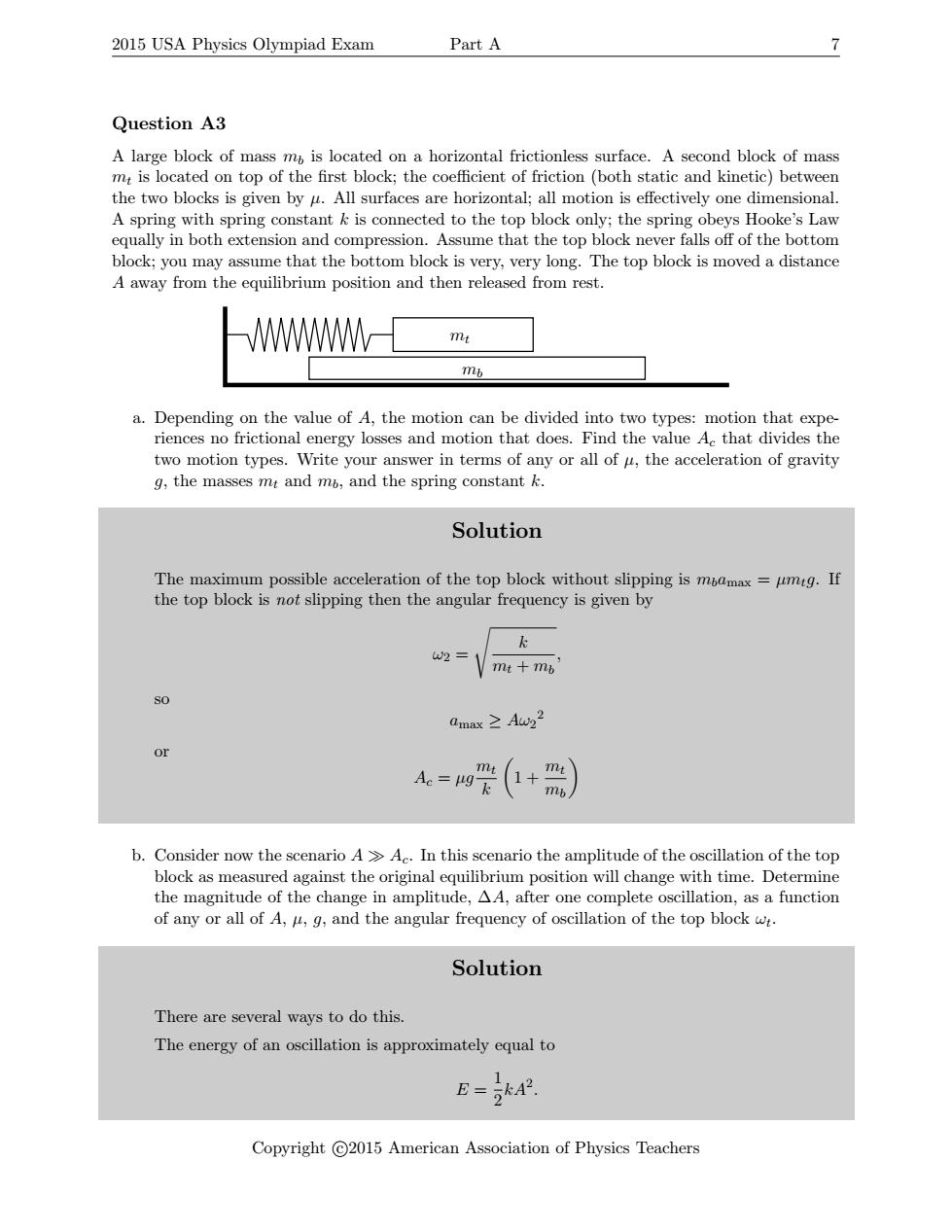正在加载图片...

2015 USA Physics Olympiad Exam Part A > Question A3 A large block of mass mo is located on a horizontal frictionless surface.A second block of mass mt is located on top of the first block;the coefficient of friction (both static and kinetic)between the two blocks is given by u.All surfaces are horizontal;all motion is effectively one dimensional. A spring with spring constant k is connected to the top block only;the spring obeys Hooke's Law equally in both extension and compression.Assume that the top block never falls off of the bottom block;you may assume that the bottom block is very,very long.The top block is moved a distance A away from the equilibrium position and then released from rest. WWWWMG mb a.Depending on the value of A,the motion can be divided into two types:motion that expe- riences no frictional energy losses and motion that does.Find the value Ac that divides the two motion types.Write your answer in terms of any or all of u,the acceleration of gravity g,the masses mt and mb,and the spring constant k. Solution The maximum possible acceleration of the top block without slipping is moamax=umtg.If the top block is not slipping then the angular frequency is given by k w2=1 mi+mb amax≥Aw22 or Ae= mt b.Consider now the scenario A>Ac.In this scenario the amplitude of the oscillation of the top block as measured against the original equilibrium position will change with time.Determine the magnitude of the change in amplitude,AA,after one complete oscillation,as a function of any or all of A,u,g,and the angular frequency of oscillation of the top block wt. Solution There are several ways to do this. The energy of an oscillation is approximately equal to B=kA2. Copyright C2015 American Association of Physics Teachers2015 USA Physics Olympiad Exam Part A 7 Question A3 A large block of mass mb is located on a horizontal frictionless surface. A second block of mass mt is located on top of the first block; the coefficient of friction (both static and kinetic) between the two blocks is given by µ. All surfaces are horizontal; all motion is effectively one dimensional. A spring with spring constant k is connected to the top block only; the spring obeys Hooke’s Law equally in both extension and compression. Assume that the top block never falls off of the bottom block; you may assume that the bottom block is very, very long. The top block is moved a distance A away from the equilibrium position and then released from rest. mb mt a. Depending on the value of A, the motion can be divided into two types: motion that experiences no frictional energy losses and motion that does. Find the value Ac that divides the two motion types. Write your answer in terms of any or all of µ, the acceleration of gravity g, the masses mt and mb, and the spring constant k. Solution The maximum possible acceleration of the top block without slipping is mbamax = µmtg. If the top block is not slipping then the angular frequency is given by ω2 = s k mt + mb , so amax ≥ Aω2 2 or Ac = µg mt k 1 + mt mb b. Consider now the scenario A
Ac. In this scenario the amplitude of the oscillation of the top block as measured against the original equilibrium position will change with time. Determine the magnitude of the change in amplitude, ∆A, after one complete oscillation, as a function of any or all of A, µ, g, and the angular frequency of oscillation of the top block ωt . Solution There are several ways to do this. The energy of an oscillation is approximately equal to E = 1 2 kA2 . Copyright c 2015 American Association of Physics Teachers